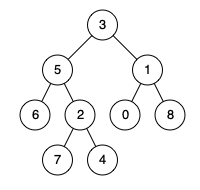LeetCode 236. Lowest Common Ancestor of a Binary Tree
Problem
LeetCode 236. Lowest Common Ancestor of a Binary Tree
1. 题目简述
给出一棵二叉树树,给出其两个节点p和q,找出p和q的高度最低公共ancestor节点,本身也是自己的祖先节点。例如:

Input: root = [3,5,1,6,2,0,8,null,null,7,4], p = 5, q = 1
Output: 3
Explanation: The LCA of nodes 5 and 1 is 3.
2. 算法思路
recursion 或 stack + hash table
和二叉搜索树的问题不同,二叉树并没有其良好的有序性,不能取巧剪枝很多,所以要完全抛弃掉之前的思路。
那么如何进行查找呢?这里有两种思路。一种是递归,另一种是stack + hashmap。
第一种思路。对于某节点node,我们定义left,mid和right三个int变量,left变量表示在node的左节点上是否存在p或q节点(0不存在,1存在),mid表示node节点本身是否存在p或q节点,right表示node的右子树上是否存在p或q节点。对于我们要找的目标节点target,left+mid+right一定是等于2的,而对于其他节点来说,left+mid+right最多为1,遍历整棵树,可得到目标节点。
第二种思路。我们先存储p的所有祖先节点,然后q节点不断向上找父节点,直到找到某个节点也在p的祖先节点列表中。我们用map来存储<node, father>键值对,进行遍历,直至map中的key包含了p和q。然后,将p一级级向上查找父节点,直至为null,存储到一个set中;随后对q进行同样操作,直至q包含在set中,此时,q记为所求。
注意,这里一层层遍历时,只能选择前序遍历或者BFS,不能选择中序遍历或者后续遍历,因为有”map.containsKey(p) && map.containsKey(q)”作为终止条件,后面两种遍历方式有可能导致ancestors的关系记录不完全!!!!有反例。
Corner Cases:
注意lowestAncestor是p或q本身的情况。
3. 解法
- 递归
1
2
3
4
5
6
7
8
9
10
11
12
13
14
15
16
17
18
19
20
21
22
23
24
25
26
27
28
29
30
31
32
33
34
35
36
37
38
39
40
|
class Solution {
TreeNode lowestAncestor;
public TreeNode lowestCommonAncestor(TreeNode root, TreeNode p, TreeNode q) {
findPQ(root, p, q);
return lowestAncestor;
}
private boolean findPQ(TreeNode node, TreeNode p, TreeNode q) {
if (lowestAncestor != null) {
return false;
}
if (node == null) {
return false;
}
int left = findPQ(node.left, p, q) ? 1 : 0;
int right = findPQ(node.right, p, q) ? 1 : 0;
int mid = ((node == p) || (node == q)) ? 1 : 0;
if (left + mid + right == 2) {
lowestAncestor = node;
}
if (left + mid + right > 0) {
return true;
}
return false;
}
}
|
- 记录父节点
1
2
3
4
5
6
7
8
9
10
11
12
13
14
15
16
17
18
19
20
21
22
23
24
25
26
27
28
29
30
31
32
33
34
35
36
37
38
39
40
41
42
|
class Solution {
TreeNode lowestAncestor;
public TreeNode lowestCommonAncestor(TreeNode root, TreeNode p, TreeNode q) {
Map<TreeNode, TreeNode> map = new HashMap();
Set<TreeNode> ancestorP = new HashSet();
Stack<TreeNode> stack = new Stack();
map.put(root, null);
stack.push(root);
while (!stack.isEmpty()) {
TreeNode node = stack.pop();
if (node.right != null) {
stack.push(node.right);
map.put(node.right, node);
}
if (node.left != null) {
stack.push(node.left);
map.put(node.left, node);
}
if (map.containsKey(p) && map.containsKey(q)) {
break;
}
}
while (p != null) {
ancestorP.add(p);
p = map.get(p);
}
while (q != null) {
if (ancestorP.contains(q)){
return q;
}
q = map.get(q);
}
return null;
}
}
|
